SANTO DOMINGO CULTURAL CENTER
The Santo Domingo Cultural Center is a cultural complex that is located in what was one of the most important convents in the colony. It is a large convent in which the Museum of the Cultures of Oaxaca, the Fray Francisco de Burgoa Library and the Ethnobotanical Garden have been established.
The Néstor Sánchez Public Newspaper Library is located in a building that is part of the complex but dates from the 19th century. Apart from all these institutions brought together, the Santo Domingo Cultural Center has multipurpose spaces in the former convent, in which temporary exhibitions, conferences, courses, book presentations and concerts are held, among many other activities.
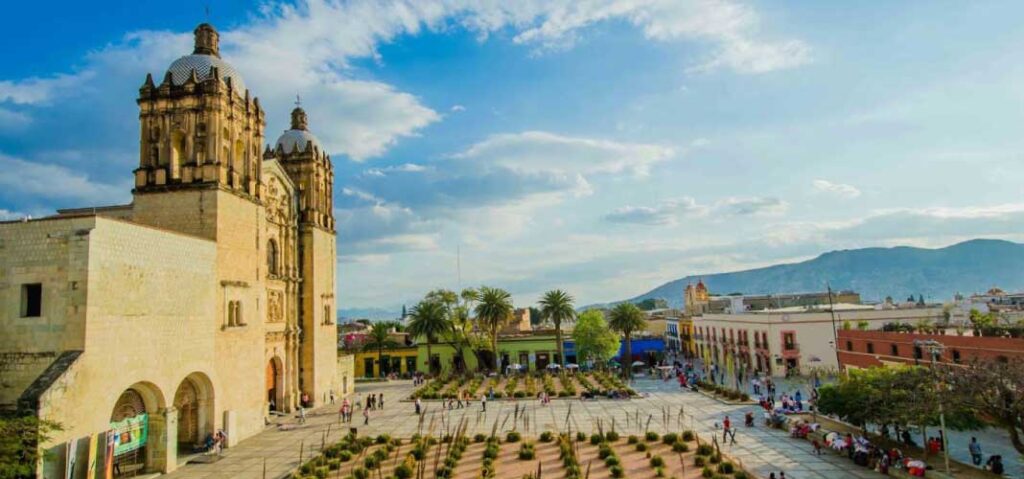
Ex-convent of Santo Domingo
The former convent of Santo Domingo de Guzmán is perhaps the largest and most important standing viceregal construction in Mexico and probably in all of America, due to its monumentality, its artistic value and the role it played as a center for evangelization and cultural promotion. for the territory of what is currently the State of Oaxaca. Santo Domingo is part of the historic center of the City of Oaxaca, which has been declared a cultural heritage of humanity by the United Nations Organization for Education and Culture.
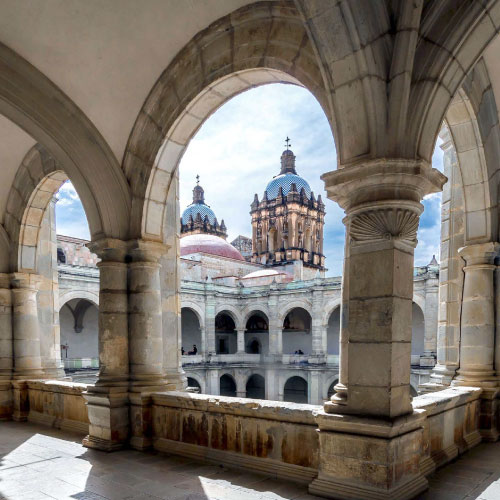
The construction of the convent began in the middle of the 16th century and would last until the beginning of the 17th century, on an area that reached 40,000 square meters. During the colony, Santo Domingo was the center of an evangelization practically monopolized by the Dominican order throughout the State of Oaxaca.
As a result of independence and when the confiscation of the assets of the clergy was decreed with the Reform Laws, the building was evicted and occupied by the armed forces. The Temple was closed to worship in 1866 and reopened in 1902, but the building that occupied the convent remained in the hands of the Mexican army. Parts of it were gradually transferred until in 1993, the army definitively evicted the property and it was used for cultural purposes.
During four years, architectural and movable property restoration works, museum planning, historical research, anthropology and the natural environment of the Oaxacan territory were carried out, thanks to the joint effort of the federal and state governments, private initiative and civil society.
 Remodeling
Remodeling
With the purpose of rescuing the original appearance of the building, for more than fifty months, at least six thousand square meters of construction and ten thousand square meters of flattening were restored Direct employment was given to around a thousand people in the most intense seasons of the process restoration; Some construction techniques used by the Dominican order in the 6th century were recovered and a set of trades that were little practiced by Oaxacan artisans and workers such as ironwork, stonework, and plasterwork were removed from oblivion.
Of the restoration work carried out in Santo Domingo, the restitution of six thousand square meters of vaults stands out, almost 50 percent of the original total. This required the intervention of a large interdisciplinary team, made up of archaeologists, architects, and historians, among others, who undertook the task of investigating, both in the archives of the cities of Oaxaca and Mexico, as well as by making coves. in walls and floors, what were the original characteristics of the building, in order to justify, from the historical point of view, all the architectural replacements that took place.
Finally, on July 24, 1998, the Santo Domingo Cultural Center opened its doors to the public, which integrates activities of four institutions: the Museum of Cultures of Oaxaca, the Ethnobotanical Historical Garden of Oaxaca, the “Fray Francisco de Burgoa” Library. , the Public Newspaper Library “Periodista Néstor Sánchez Hernández”, in addition to the areas dedicated to conferences, congresses, seminars, temporary exhibitions, courses, concerts, etc.
The Museum
On the upper floor is the Museum of the Cultures of Oaxaca, through a new museum language and along 14 permanent exhibition rooms and 13 thematic rooms, visitors are provided with a broad panorama of the historical development in the entity. In this new enclosure, visitors can appreciate the permanent and determining presence of indigenous groups in shaping the current physiognomy of Oaxacan society.
In its rooms it is possible to admire the most outstanding archaeological pieces from Monte Albán -for example, the world-famous jewels of Tomb 7- Mitla, Yagul Lambityeco, Dainzú, Huijazoo and other pre-Hispanic sites, as well as various objects that account for the traits and continuity of the millenary culture of Zapotecs, Mixtecs, Mixes, Huaves, Triqui and other ethnic groups of the State of Oaxaca, emphasizing that these groups are a dynamic part of everyday Oaxacan events.
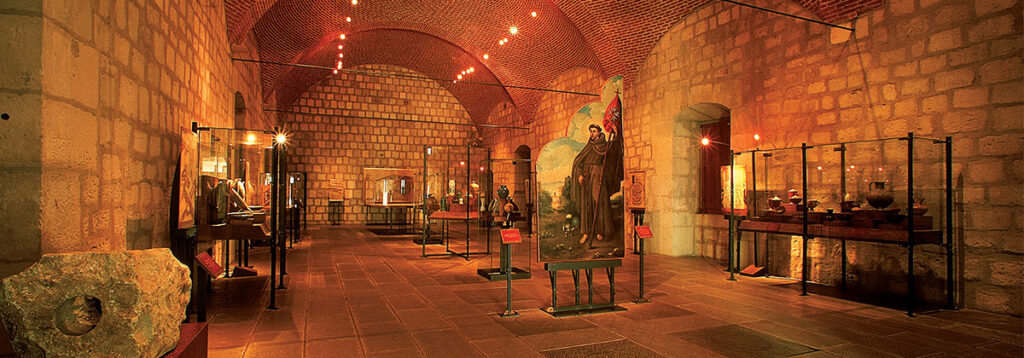
This site has been organized around a museum proposal that seeks to simultaneously meet the informational requirements of the different types of visitors (students, tourists, researchers, etc.). A novel aspect is the incorporation in the rooms of computer monitors where in an agile and even fun way it is possible to delve into some aspect of the history and anthropology of the entity.
The museum is divided into fourteen rooms that cover 10 thousand years of the state’s history, from the emergence of the first sedentary settlements and the flourishing of the great pre-Hispanic cultures, passing through different aspects of the conquest and the colony, the independent era, to reach the twentieth century. Room 3 stands out, where the jewels found in the early 1930s are on display in Tomb 7 of Monte Albán, considered one of the most important treasures in all of Mesoamerica.
The so-called “interactive rooms” are located in rooms V to VII in thirteen small cells. They have been conceived as spaces in which the public can touch the objects they appreciate and obtain more information, with the support of multimedia technology. They are dedicated to different craft trades in Oaxaca: textiles, ceramics, goldsmithing, wood carving and sculptures, saddlery, tinsmithing, etc .; the production of natural dyes, such as cochineal grana; traditional medicine; music; gastronomy; and the production of beverages such as mezcal, among others.
Ethnobotanical Garden
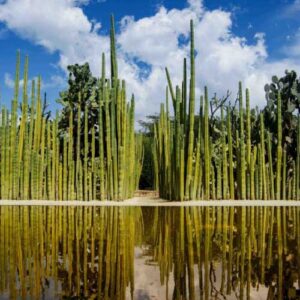 The next cultural space of this complex is the Ethnobotanical Historical Garden of Oaxaca, whose objective is to make known the abundance and peculiarities of the flora of the State, traditional crops, and rescue the knowledge that the indigenous peoples of Oaxaca have about the flora of your region.
The next cultural space of this complex is the Ethnobotanical Historical Garden of Oaxaca, whose objective is to make known the abundance and peculiarities of the flora of the State, traditional crops, and rescue the knowledge that the indigenous peoples of Oaxaca have about the flora of your region.
By showing live links between the biological and ethnic diversity of Oaxaca, the Ethnobotanical Garden complements and enriches the Museum of Cultures of Oaxaca and the “Francisco de Burgoa” Library. This relationship between the Garden and the Cultural Center is unprecedented in Mexico.
Library
Another space of the new Santo Domingo de Oaxaca Cultural Center is the “Fray Francisco de Burgoa” Library, formed with the historical collection of the “Benito Juárez” Autonomous University of Oaxaca. The library occupies the space of the old chapel of the Third Order, one of the largest rooms in the Ex-Convent. It has more than 23 thousand volumes published between 1484 and 1940, mostly collections owned by different religious orders settled in Oaxaca.
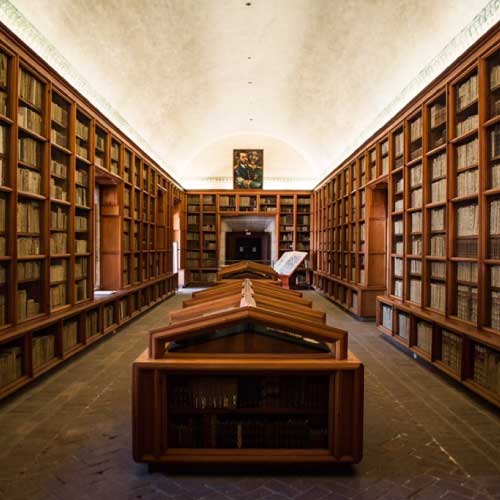 These collections were seized in the 19th century, following the enactment of the Reform Laws. Among its most precious treasures are eleven incunabula, some first Mexican prints, a Latin manuscript by Fray Bartolomé de las Casas and the work: “Comments on the philosophy of Aristotle” by Juan Versor, published in Latin in 1484. It also has the important bibliographic collections of Benito Juárez Maza, Matías Romero, Jacobo Dalevuelta and Aurelio Valdivieso, whose consultation is reserved for researchers.
These collections were seized in the 19th century, following the enactment of the Reform Laws. Among its most precious treasures are eleven incunabula, some first Mexican prints, a Latin manuscript by Fray Bartolomé de las Casas and the work: “Comments on the philosophy of Aristotle” by Juan Versor, published in Latin in 1484. It also has the important bibliographic collections of Benito Juárez Maza, Matías Romero, Jacobo Dalevuelta and Aurelio Valdivieso, whose consultation is reserved for researchers.
The Public Newspaper Library “Periodista Néstor Sánchez Hernández”, located in the old cavalry building, built by the Dominican fathers for the Mexican army in 1902, in gratitude for having returned the Temple of Santo Domingo to that religious order, has two spacious rooms for reading, where it is possible to consult the main newspapers of local and national circulation, as well as various publications in other languages. In the first one are newspapers and magazines of the current day and month. In the second, the oldest, among which are newspapers in the region dating from the middle of the last century, and a newspaper with national circulation since 1978.
In addition, the center has several rooms, classrooms and an auditorium, in which exhibitions, congresses, forums, concerts, courses, workshops, recitals, stage presentations, book fairs and a wide range of activities are organized. A cafeteria and a store-bookstore complement the services of a center that is destined to further enrich the artistic and cultural life of the city of Oaxaca.
How to get:
More Tourist Attractions in OAXACA
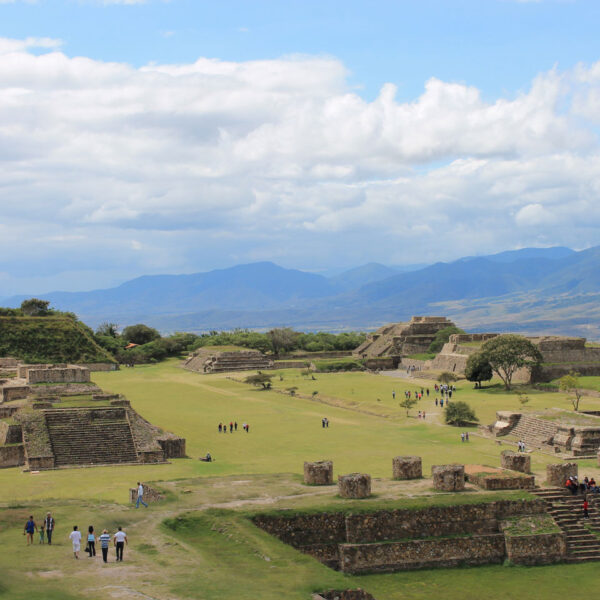
Monte Alban
Monte Alban is the most important archaeological zone of the Oaxacan entity, of unique regional importance due to the religious, political and economic control that the Zapotec state exercised over the population of the Valley of Oaxaca for more than thirteen centuries. It has been named by UNESCO Cultural Heritage of Humanity together with the city of Oaxaca on December 11, 1987. The heritage of the Zapotec world reaches us through the magnificent archaeological sites designed in the Valley of Oaxaca. Of these, the city of Monte Albán stands out for its enormous importance as an economic, political and religious hub (it was the first urban complex in Mesoamerica); by its extension, almost as big as the current capital of Oaxaca; and for its long life, started around 500 BC and concluded around 850 AD.… Read More
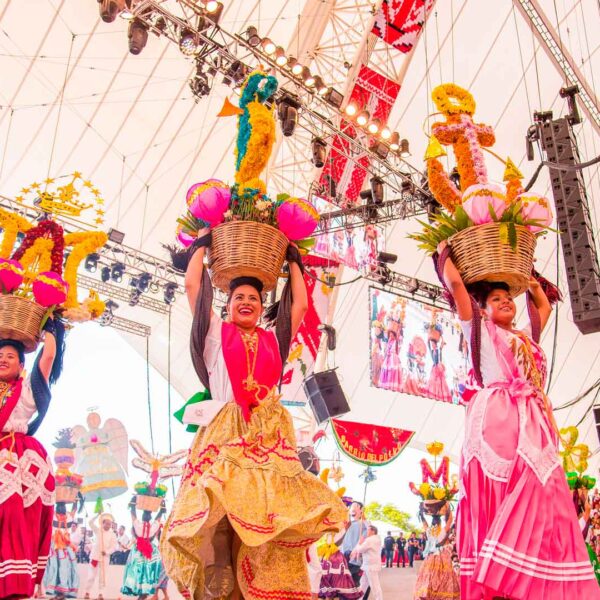
La Guelaguetza
The Guelaguetza is an ancient tradition with pre-Hispanic roots related to agricultural ceremonies of gratitude to the gods for the arrival of the rains and the lifting of the harvest at the end of July and is the largest festival in Oaxaca. La Guelaguetza is a celebration of gratitude for the arrival of the rains and the harvests, in which representatives from all regions of the state gather in the capital to share their culture through dances, crafts and food. La Guelaguetza is celebrated every year on the two Mondays after July 16, except when the first Monday is July 18, Benito Juárez’s death anniversary. Many types of dances also participate, such as the traditional Flor de Piña; where women usually dress in Huipiles representing the different regions of the state, as well as with their pineapple on their shoulders, they comb their hair with beautiful long braids accompanied by their ribbons and can not missing her accessories that is, bracelets, necklaces and earrings of precious colors and her beautiful makeup.… Read More

Mezcal
Mezcal is a rich, handcrafted flavored drink that requires considerable attention to be produced. Mezcal is normally served with white salt or worm salt (salt mixed with a cooked larva and ground chili), lemon or orange. Mezcal production today remains more or less as it was when the Spanish arrived hundreds of years ago. Each “recipe” is transmitted from generation to generation within the families that care about its production; Because each family has its own approach to mezcal production, there are an enormous number of different flavors. It is also in this way that the rich diversity of flavors and traditions are preserved for all to enjoy.… Read More
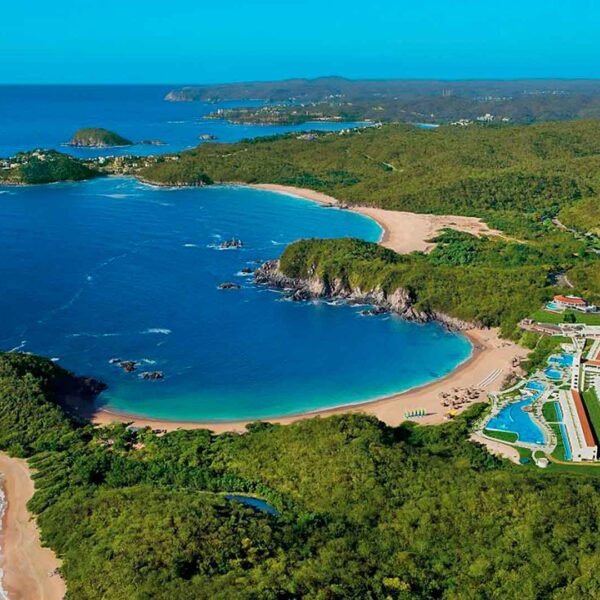
Beaches in Oaxaca
The beaches of the coast of the state of Oaxaca are among the most beautiful and complete in Mexico, thanks to a developing tourist infrastructure and the rich gastronomy of the Pacific. Along the 533 kilometers of coastline, the beaches of Oaxaca offer a wide variety of activities for lovers of water sports: snorkeling, diving, sport fishing, surfing, among others… there is something for everyone!… Read More
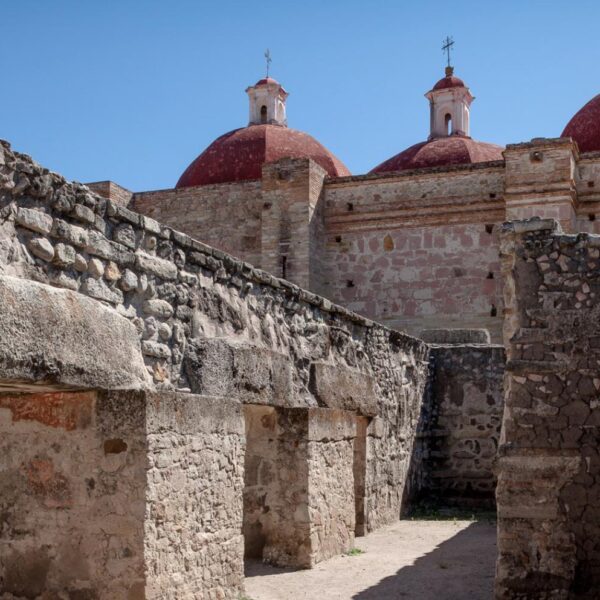
Archaeological Sites in Oaxaca
Oaxaca is famous throughout the world for its archaeological sites and the history they keep. Discover Monte Alban, Mitla, Yagul and more of these remote sites, which have made Oaxaca a World Heritage city, according to Unesco. The original Zapotec and Mixtec peoples of Oaxaca lived in the cities and religious centers of the valley of this city until the time of Spanish colonization. Today, there are still vestiges of these towns and places where you can meet them.… Read More
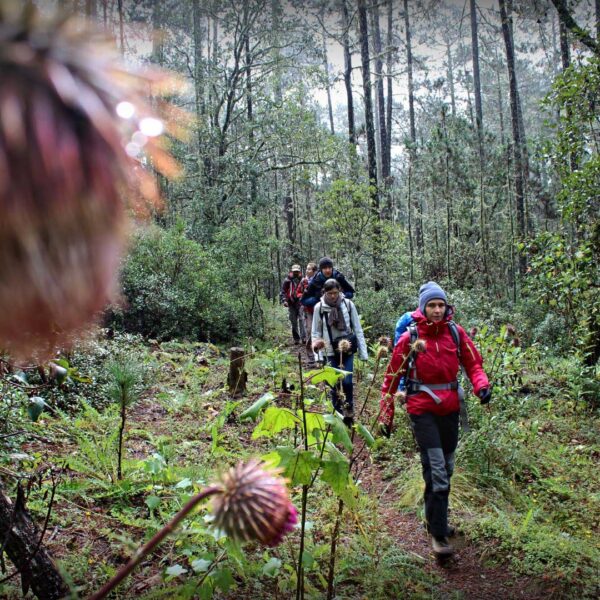
Ecotourism and Adventure in Oaxaca
Oaxaca, located in the southeast of Mexico, is an example of a singular miscegenation that even in the midst of modernity never forgets its origins. In its varied geography, it brings together not only a vast biodiversity, considered among the largest in the world, but also insurmountable cultural and ethnic riches, and the most different and beautiful natural settings. An ideal space for Alternative Tourism, Oaxaca offers activities such as walking, mountain biking, rappelling, climbing, zip-lining, horseback riding, observation of flora and fauna and more, in close contact with nature. The visitor can also witness the various aspects of local life, savor the gastronomy and enjoy the warmth of its people, as well as an offer of accommodation in hotels, ecotourism cabins, local houses or excellent camping areas.… Read More
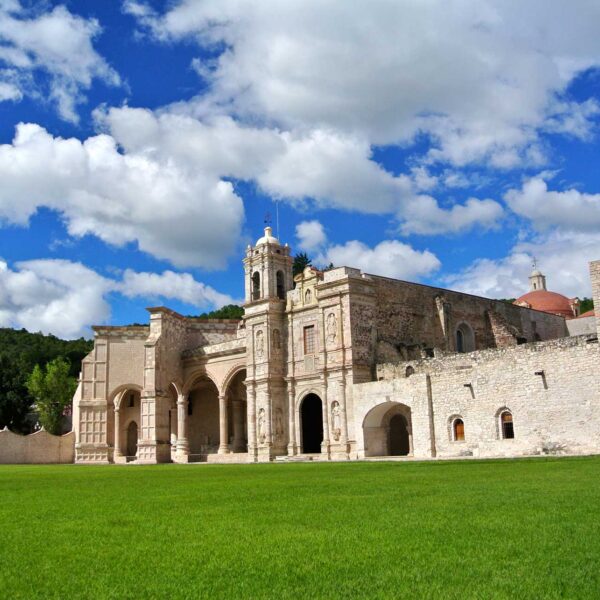
Magical Towns in Oaxaca
In Oaxaca we are proud to have 5 communities that have been awarded the title of Magical Towns of Mexico, a Magical Town is a town that has symbolic attributes, legends, history, transcendent events, everyday life, in short magic that they emanate in each of their socio-cultural manifestations, and that today mean a great opportunity for tourist use. The Magic Towns Program contributes to revalue a group of populations in the country that have always been in the collective imagination of the nation as a whole and that represent fresh and different alternatives for national and foreign visitors.… Read More
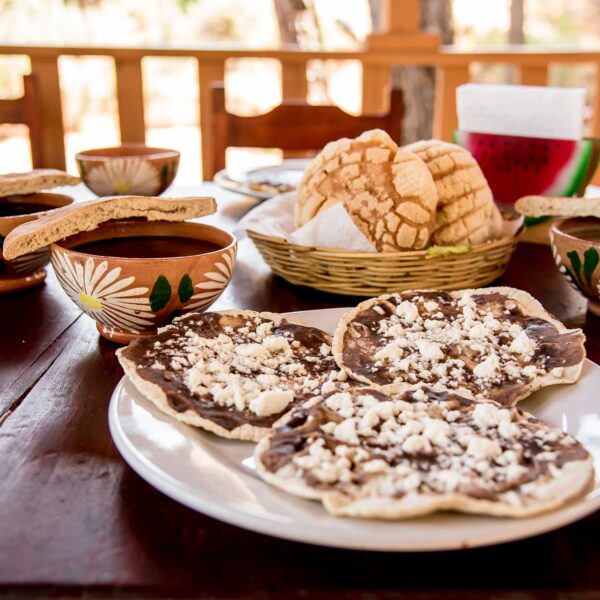
Gastronomy of Oaxaca
The Oaxacan gastronomy takes you on an amazing journey into one of the most outstanding and colorful cuisines in the world. Oaxacan food is among the most varied and delicious in Mexico, UNESCO has declared it Humanity’s Cultural Patrimony. Oaxaca’s gastronomy incorporates elements of pre-Hispanic cuisine, and lively imagination has created combinations that amaze by the color, the aromas and the flavors.
The list of dishes that characterize this cuisine is endless, however, we can mention: Oaxacan Mole in its 7 varieties depending on the type of chili used, Chapulines, (dry roasted, spiced grasshoppers), tlayudas (large tortilla spread with the remaining of the lard and beans), maguey worm sauce, chiles rellenos (stuffed chilies), and of course the famous Oaxacan tamales in banana leaves. Oaxaca cheese is a soft white string cheese, which is similar to mozzarella. It is sold in “ropes” which are wound onto themselves into balls, and eaten cold or lightly melted on quesadillas is considered among the best in the world.… Read More
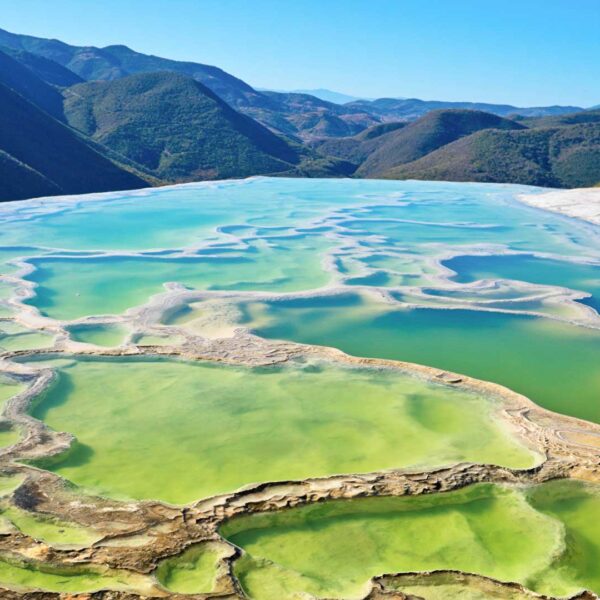
Oaxaca City Surroundings
Oaxaca is a destination that offers a great variety of attractions and tourist charms which leave anyone surprised. When arriving in the city of Oaxaca, the most common is to visit the historic center, the Santo Domingo Temple, the Macedonio Tourist Walk, the gastronomic delights in the Benito Juárez market, the Basilica de la Soledad, among other attractions. And one of the places that you cannot miss is the Monte Alban archaeological zone, which is approximately 30 minutes by car from the historic center. However, there are other places that are also worth knowing and are in the surroundings of the city. For this reason we recommend the following tourist routes.… Read More
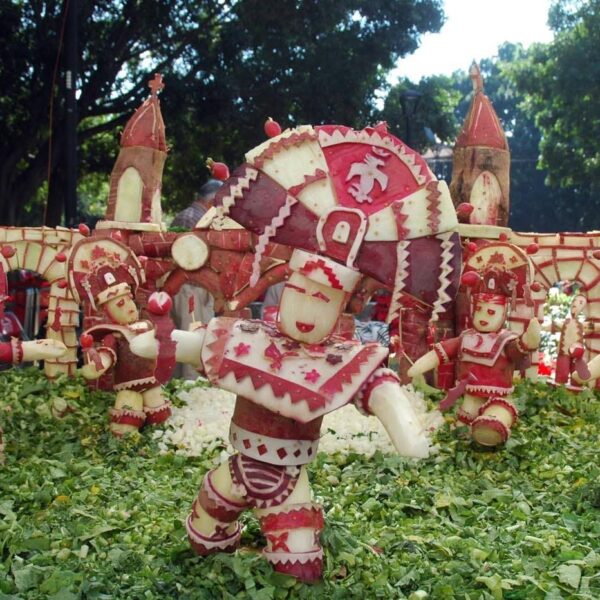
Traditions of Oaxaca
In the state of Oaxaca there are many customs and traditions throughout the year, and within the state, said that they have the same purpose of celebration but with different things, in fact from one region to another or even more from one town to another, the Customs vary for perhaps details but that is what makes them authentic. All the holidays are celebrated, the profane and the religious ones. The festival calendar is extensive due to the diversity of ethnic groups, which they still conserve. Oaxaca has a combination in its traditions of the culture of the ancestors and the current culture, a state that does not lose its customs, adapts them to new times and needs.… Read More
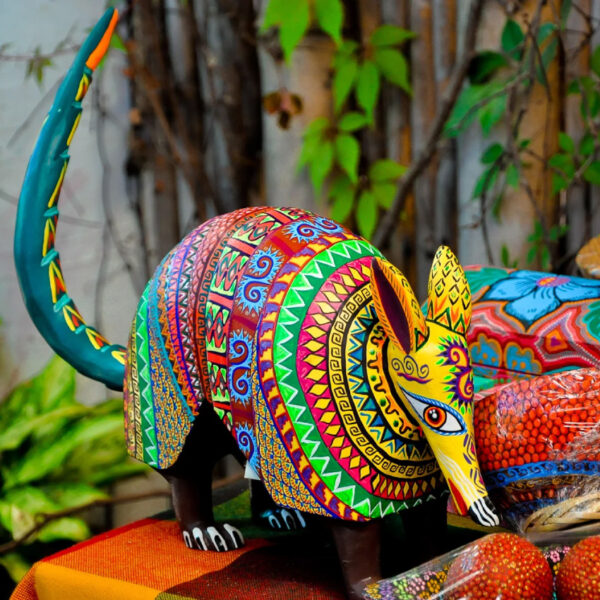
Handicrafts from Oaxaca
Handicrafts from Oaxaca are a great tradition and they offer a diversity that denotes the artistic richness and imagination of its people. The talented artisans of Oaxaca make beautiful pieces of clay, textiles, wood, metal, skins and other materials, forming a rich and varied folk art in both decorative and useful items.… Read More
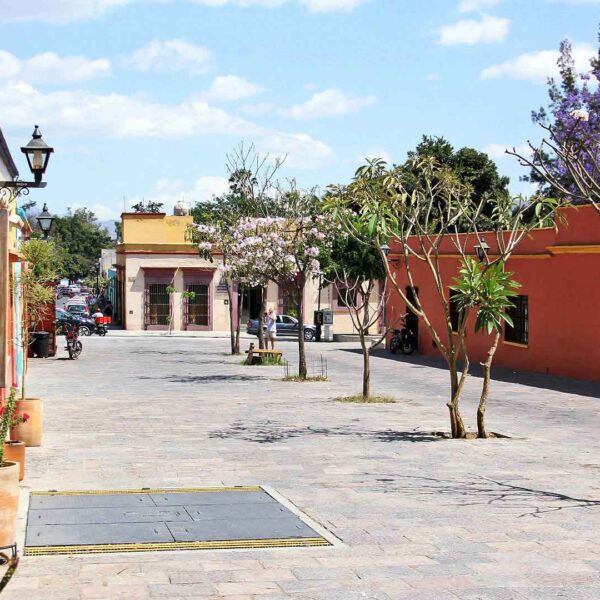
Oaxaca City
Oaxaca is the most diverse state in Mexico. It has peaks that reach more than 3,000 meters high, caverns that are among the deepest in the world, virgin beaches, secluded forests, and sunlit valleys. Oaxaca is rich in traditions and customs and has the largest ethnic population found in Mexico.
The City of Oaxaca, the state capital, is famous for its architecture and for its rich cultural traditions. Oaxaca is also graced by a splendid and varied cuisine and spring-like weather year round. UNESCO declared the city a Cultural Heritage Site.… Read More
Guided Tours in OAXACA
Flights & Hotels in OAXACA
More Tourist Attractions in MEXICO

Ecotourism and Adventure
Mexico is one of the best countries for Ecotourism as it has a great variety of flora and fauna, as well as a large number of refuges for extraordinary species. You can enjoy recreational activities of appreciation and knowledge of nature through contact with it, such as: stargazing, observation of natural attractions, wildlife and bird watching. Throughout México there are more than 176 protected natural areas, 5 of them considered by UNESCO as Natural Heritage of Humanity. Just for this and much more, we believe that Mexico is a Paradise for Ecotourism.… Read More

Traditions in Mexico
It is practically impossible to make a meticulous, and above all, accurate selection of the places to visit in Mexico. Each place that our country houses is unique and beautiful in its own way. Mexico, with its nearly 2 million km², has a large number of scenarios to offer, as well as endless activities to do. Do not lose your way and enter the places to visit in Mexico. In Mexico, apart from the beaches and its famous archaeological sites, there are many other really interesting sites and activities that you should know. In the surroundings of the main cities you will find places full of culture and tradition, where you can spend relaxing, interesting and fun vacations. On your trip through Mexico you cannot stop obtaining souvenirs, the crafts that are made here are of the highest quality and recognized worldwide. A shopping tour cannot be missed.… Read More

States Of Mexico
Mexico has an incredible diversity of landscapes, where the beauty of its beaches, internationally recognized, stands out. In its vast territory of coasts, there are beaches of unparalleled beauty, and colorful landscapes. A large network of first-class hotels and tourist services is available to visitors to these beaches. Mexico is also mystical places, dotted with archaeological testimonies inherited from its original inhabitants. Monuments made by the Mayas, Aztecs and Toltecs are located in magical landscapes, like lighthouses in an ocean of natural beauty. They offer visitors buildings that tell their history, and museums that collect their cultural heritage. And that keep alive ancestral traditions, in ceremonies and festivals, where you can enjoy cultural activities and entertainment.… Read More

Capital Cities
Folklore, gastronomy, literary culture, art and exhibitions, is what you will find in the capitals of the states of Mexico. To the north, colonial Mexico, Puebla, Guadalajara, Guanajuato, the Sonoran desert and the California peninsula. To the east Veracruz and the gulf. To the west Acapulco, Oaxaca and Tuxtla Gutiérrez. And to the south the Riviera Maya and the pyramids of Chichén-Itzá, Tulúm and Cobá in Yucatán, Palenque in Chiapas, the cenotes, and the Central American jungles.… Read More

Beaches
On the Beaches of Mexico you can immerse yourself in the intense blue ocean of the Pacific bays, sunbathe on the shore of the warm and transparent waves of the Caribbean Sea in Quintana Roo or even rest on the beautiful coasts of the Gulf of Mexico. Mexican beaches hide wonderful secrets for the traveler. By visiting them, in addition to enjoying the excellent climate and water activities, you can discover splendid archaeological sites and interesting colonial cities without traveling long distances.… Read More

Magical Towns
A Magical Town is a place with symbols and legends, towns with history that in many cases have been the scene of transcendent events for our country, they are places that show the national identity in each of its corners, with a magic that emanates from its attractions ; visiting them is an opportunity to discover the charm of Mexico. The Magical Towns Program contributes to revalue a set of populations in the country that have always been in the collective imagination of the nation and that represent fresh and varied alternatives for national and foreign visitors. A town that through time and in the face of modernity, has conserved, valued and defended its historical, cultural and natural heritage; and manifests it in various expressions through its tangible and intangible heritage. A Magical Town is a town that has unique, symbolic attributes, authentic stories, transcendent events, everyday life, which means a great opportunity for tourist use, taking into account the motivations and needs of travelers.… Read More

Archaeological Sites
The Archaeological Zones are the cultural past of every Mexican. You will be amazed at the ambient, nature and the environment that surrounds them. Climbing to the top or being around it will take us back in time to admire every detail. México is a country of culture and traditions, many of which we have inherited from the pre-Hispanic inhabitants of this vast territory, although it is true that there were more settlements in the central and southern part of the country, it is also possible to find some archaeological remains in the north.
… Read More

Gastronomy
The Gastronomy of Mexico has a great diversity of typical dishes, which is why it was recognized by UNESCO as Intangible Heritage of Humanity. The basic and representative ingredients of Mexican dishes are: corn, coriander, chili, beans, piloncillo, nopal and tomato. Mexican cuisine is also characterized by its sauces, which serve as an accompaniment to traditional dishes, prepared based on spices.… Read More


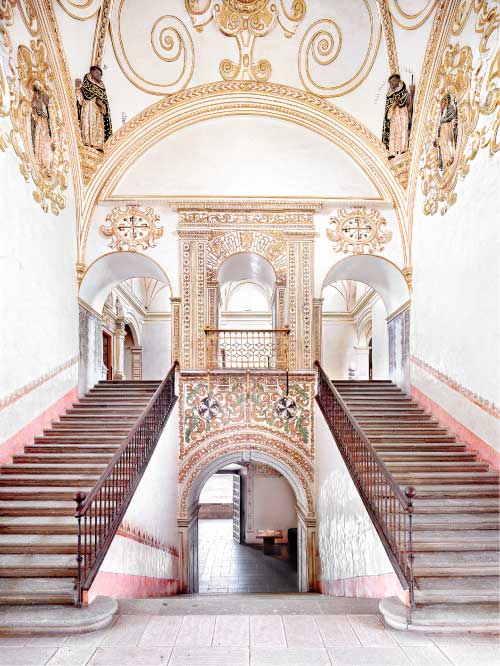 Remodeling
Remodeling